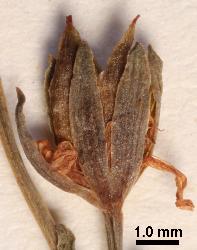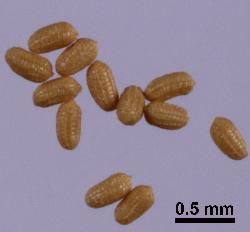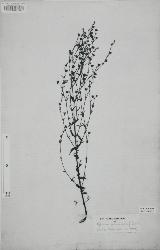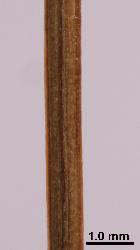- Taxon
- Gallery
- = Brathys forsteri Spach, Annales des Sciences Naturelles; Botanique sér. 2 Ser 2, 5: 367 (1836)
Herbaceous annual or perennial, not rhizomatous, up to 0.3 m high. Stems upright, up to 3.0 mm diam., quadrangular, 4-lined, black glands absent, branched along their length. Leaves 3.0–12.0 mm long, 1.0–4.0 mm wide, lanceolate, oblong-lanceolate, broadly elliptic or narrowly deltoid, glabrous, reticulate tertiary veins absent; pellucid glands numerous; black glands absent; apex obtuse or acute; margin usually slightly sinuate; base subcordate or truncate; sessile. Inflorescence lateral and terminal, monochasial, paired monochasial cymes or dichasial cymes, flowers 1–12 per cyme, corolla 4.0–10.0 mm diam. Pedicels 5.0–27.0 mm long. Bracteoles absent. Sepals 5, 3.0–5.0 mm long, 0.8–1.5 mm wide, unequal, linear-lanceolate or elliptic; pellucid glands inconspicuous and sparse; black glands absent; apex acute or subacute; margin entire. Petals 3.5–5.0 mm long, 0.8–1.6 mm wide, more or less equal or longer than sepals, oblong to oblong-obovate, yellow, black glands absent, persistent after anthesis. Stamens not in bundles, 9–15, 2.5–3.0 mm long, ½–⅔ length petals; anthers 0.2–0.3 mm long, anther gland absent. Ovary 2.8–3.0 mm long, 1.2–1.3 mm wide, ovoid. Styles 3, 0.5–0.8 mm long, more or less equals ovary. Fruit capsule, 4.8–6.0 mm long, 2.0–2.2 mm wide, ovoid, light brown, barely protruding beyond sepals, coriaceous. Seeds 0.4–0.5 mm long, c. 0.2 mm wide, oblong, terete, longitudinal ribs, apices obtuse or rounded.
H. gramineum has erect, quadrangular and 4-lined stems that branch along their length, inflorescences terminal and lateral and mostly monochasial cymes, black glands absent from the vegetative and floral parts, 3 styles, 9–15 stamens, and a small (4.8–6.0 mm long) capsule that barely protrudes beyond the sepals.
North Island: Northland, Auckland.
Also Australia, New Guinea, and New Caledonia.
Not known with certainty, but likely to be disturbed, open areas.
Also indigenous to Australia, New Caledonia, Papua New Guinea, Vietnam, Taiwan, China, India, Bhutan, and Hawaii (Robson 1990).
Flowering: Oct.–Mar.









